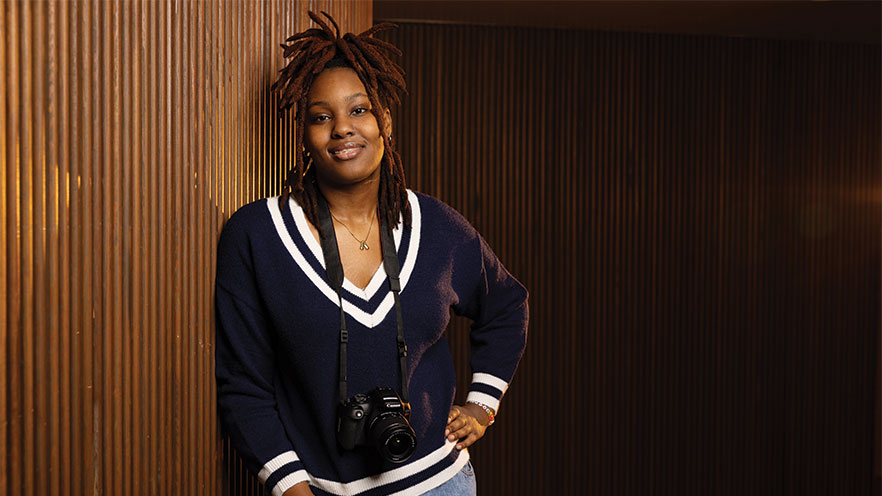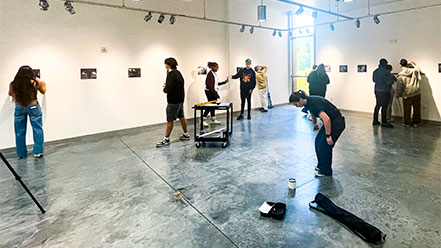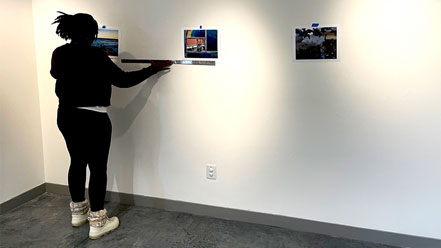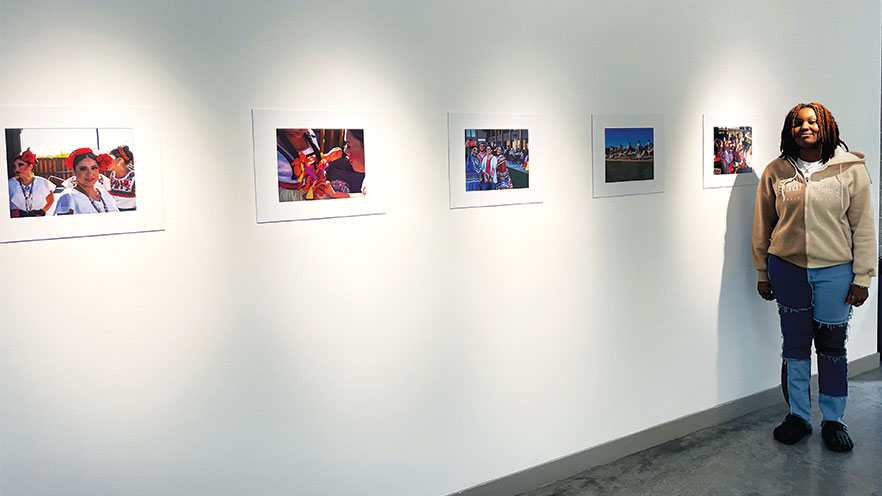Portrait of a Creative Student Leader
Asya Johnson’s Whitman experience is defined by growth, leadership, community and creativity
By Mónica Hernández Williams

Focused on her art. Asya Johnson ’26 has had her eyes on a creative future since she first stepped foot on Whitman’s campus.
Community. That’s what Asya Johnson ’26 found at Whitman College. As a first-year, she quickly joined student groups, like the Black Student Union and Women of Color Voices. In her sophomore year, she pictured a new group—one that would bring others together around a shared creative interest.
“My parents gifted me my first camera when I was in high school, and I thought that there would be other people on campus who might also like photography,” she says.
With guidance from staff in the Student Activities Office, Johnson started a student-led Photography Club in the spring of 2023 that has now grown to 20 members.
“I was a bit nervous because I hadn’t started a club before. Now, here I am the President of the Photography Club,” Johnson says. “I like a challenge because that means that I’m learning. Looking back, I’m glad I kept pushing and am thankful that I had the support of my friends and staff members to keep going.”
She also enrolled in a Beginning Digital Photography class to further develop her skills.
“I didn’t have much experience using the different manual settings of a camera because I was self-taught. Robin’s class has taught me even more,” she says, referring to Whitman’s Faculty Fellow Robin North, who specializes in photography and digital media.
“Now I can teach club members how to work the camera, instead of letting the camera work them,” she says.
North also supported Johnson in organizing a club photo exhibition in Whitman’s Fouts Center for Visual Arts this fall.
“I didn’t even know that we could do that,” she says. “It has been my favorite thing we’ve done as a club so far because different people across campus came just to see our work!”



‘Transitions in Light.’ Asya Johnson ’26 worked with the Beginning Digital Photography class to install work for a collaborative exhibition with the Photography Club. (Photos courtesy of Robin North.)
Coming to Whitman
From the moment Johnson first stepped foot on the Whitman College campus, it felt like home.
The Chicago native was initially introduced to Whitman through her high school guidance counselor and coordinated a campus visit.
“Seeing the campus with my dad … It was very beautiful. That is what made me fall in love with Whitman,” says Johnson, who had always planned to major in Art and minor in Art History. “I loved seeing that there are art pieces literally all across campus. I remember thinking how beautiful Whitman’s landscape was and how friendly everyone was to us.”
She knew what she wanted in a college—a strong Art program in a supportive community where she could explore and grow. To get a clear picture of what Whitman could offer her, she spoke to current students, professors and staff in several resource offices across campus.
“Whitman was hitting all the marks,” Johnson says. “It all just sounded right to me.”
But she wanted to base her decision on more than just a feeling, so she asked her parents for advice. Her dad believed she’d thrive at Whitman, but her mom was worried about the cost.
“I knew I would have a bright future if I came here. So I talked to the Office of Financial Aid and they were willing to work with me and my family’s situation,” she says.
That conversation led Johnson to choose to spend the next four years at Whitman.

Experiencing a New Diversity
Moving across the country was nerve-wracking for Johnson, but the butterflies soon settled once she was on campus.
She signed up for Whitman’s Summer Fly-In—a weeklong pre-orientation program designed for first-generation or working-class students to connect with campus resources and with one another.
“I got to experience the strong campus community Whitman has,” Johnson says. “I made my first college friends through the Summer Fly-In and am still friends with them to this day.”
She noticed that cultural differences were celebrated on campus.
“Chicago is very diverse, but I mainly grew up in the African American community. Coming to Whitman and being able to experience diversity for myself, learn about other cultures, and build my own community around them was pretty cool,” she says.
Johnson wanted to help future generations of Whitties experience that same feeling of support and belonging. So during her sophomore year, she became a Fly-In Leader and, soon after, an Orientation Week Leader (OWL).
“I thought it’d be pretty cool to see the same incoming students from my Fly-In group again and be a friendly and familiar face to them,” says Johnson.
Her goal was to support these students far beyond the first week of classes.
“I know I can still go to my OWL to ask for help, and she’d be happy to do so, even though I’m a junior now,” Johnson says. “So if someone helped me get through a door, why not help others go through those same doors?”
Envisioning a Creative Future
As she prepares for her senior year, Johnson looks forward to interweaving all her learnings from across campus into her senior thesis.
But what she is most excited about is life after Whitman.
“I am going to open up my own gallery—with a studio in the back—to be able to showcase my work and the work of other artists,” she says.”
See more of Johnson’s work
Photos courtesy of Asya Johnson ’26
A Visual Learner: Meet Asya’s Mentor
In the spring of 2024, Asya Johnson ’26 was nominated to serve on the hiring committee for a new Art Faculty Fellow. It was there that she first met visual artist Robin North.
In his courses, North encourages students to consider voices and perspectives often left out of mainstream visual culture. Students explore how language and terminology in photography—such as shoot, capture, headshot, take, and master/slave—carry connotations that reflect and reinforce colonial and hierarchical structures.
Johnson has been particularly engaged in those discussions and says she feels she can go to North for academic and personal guidance.
“Robin understands me in certain situations … because he is an African American man,” says Johnson. “And he is a professional, so it gives me hope for what I can do in my future.”